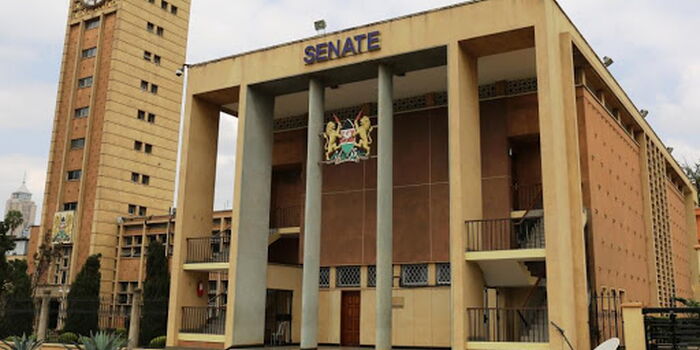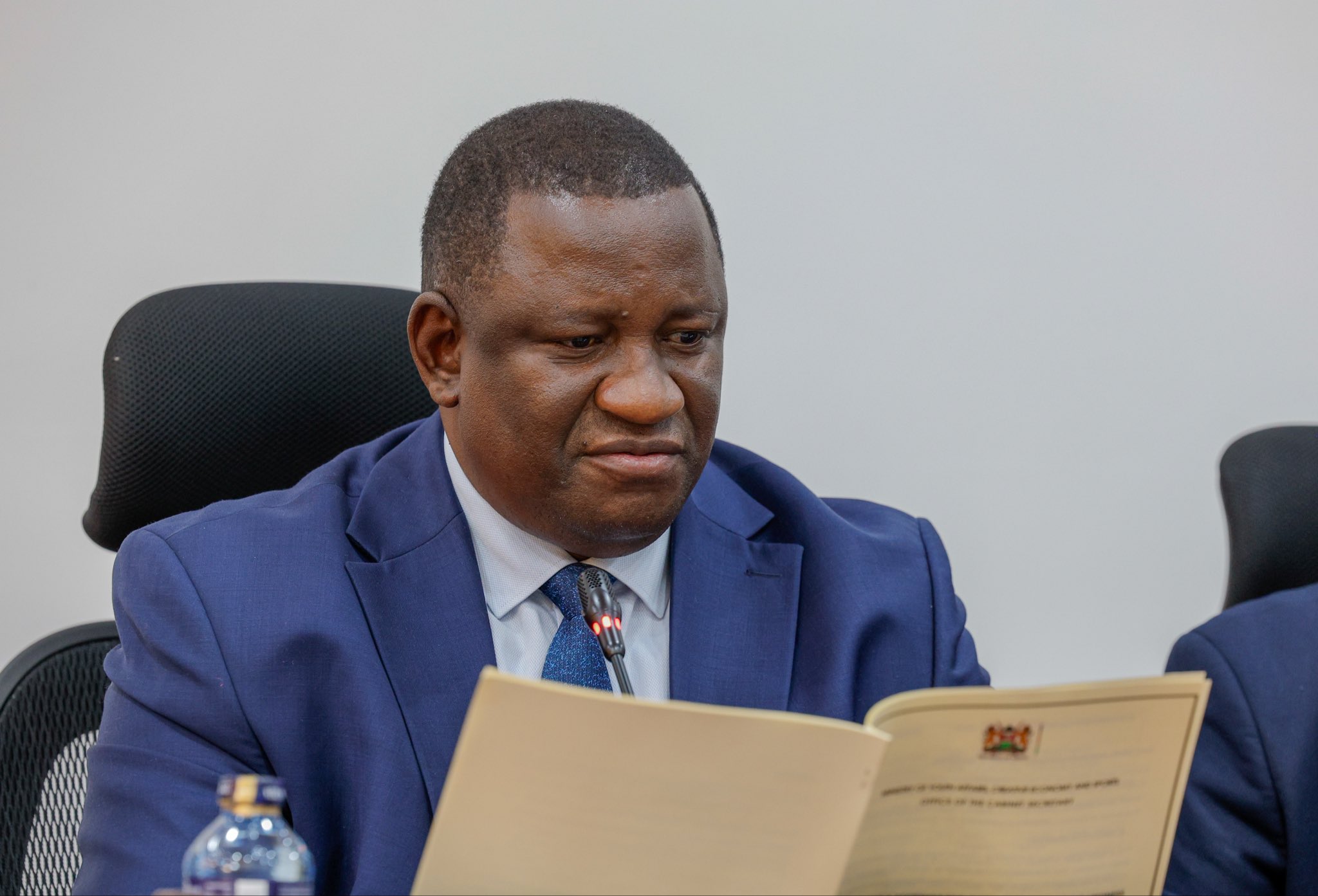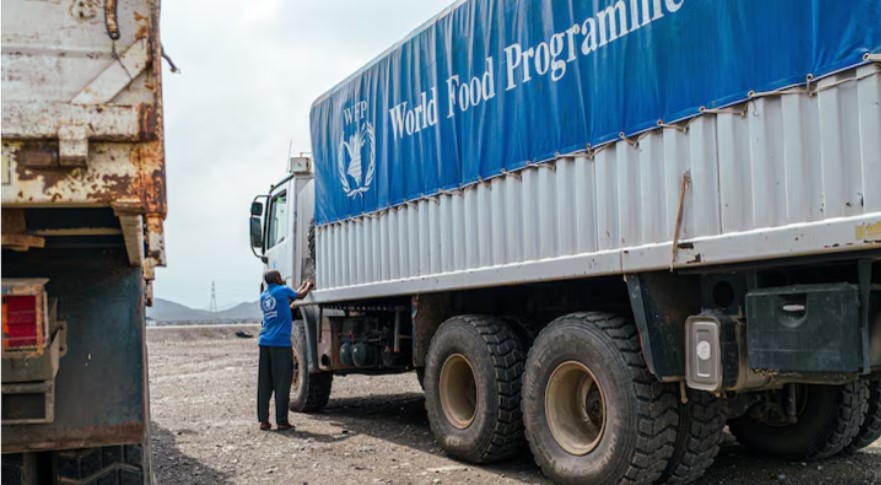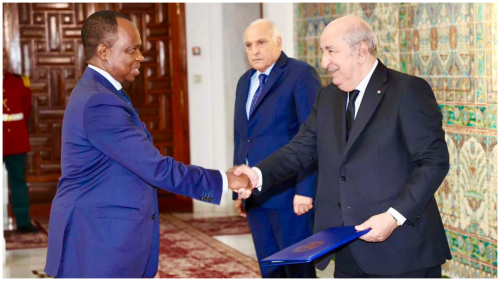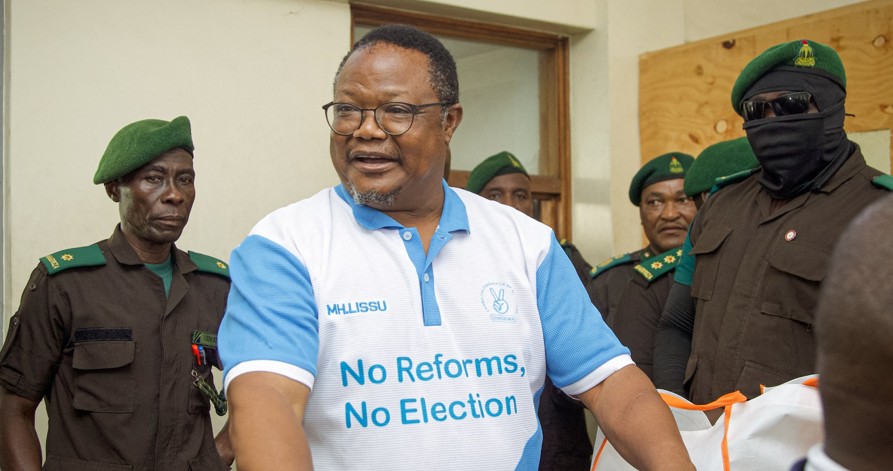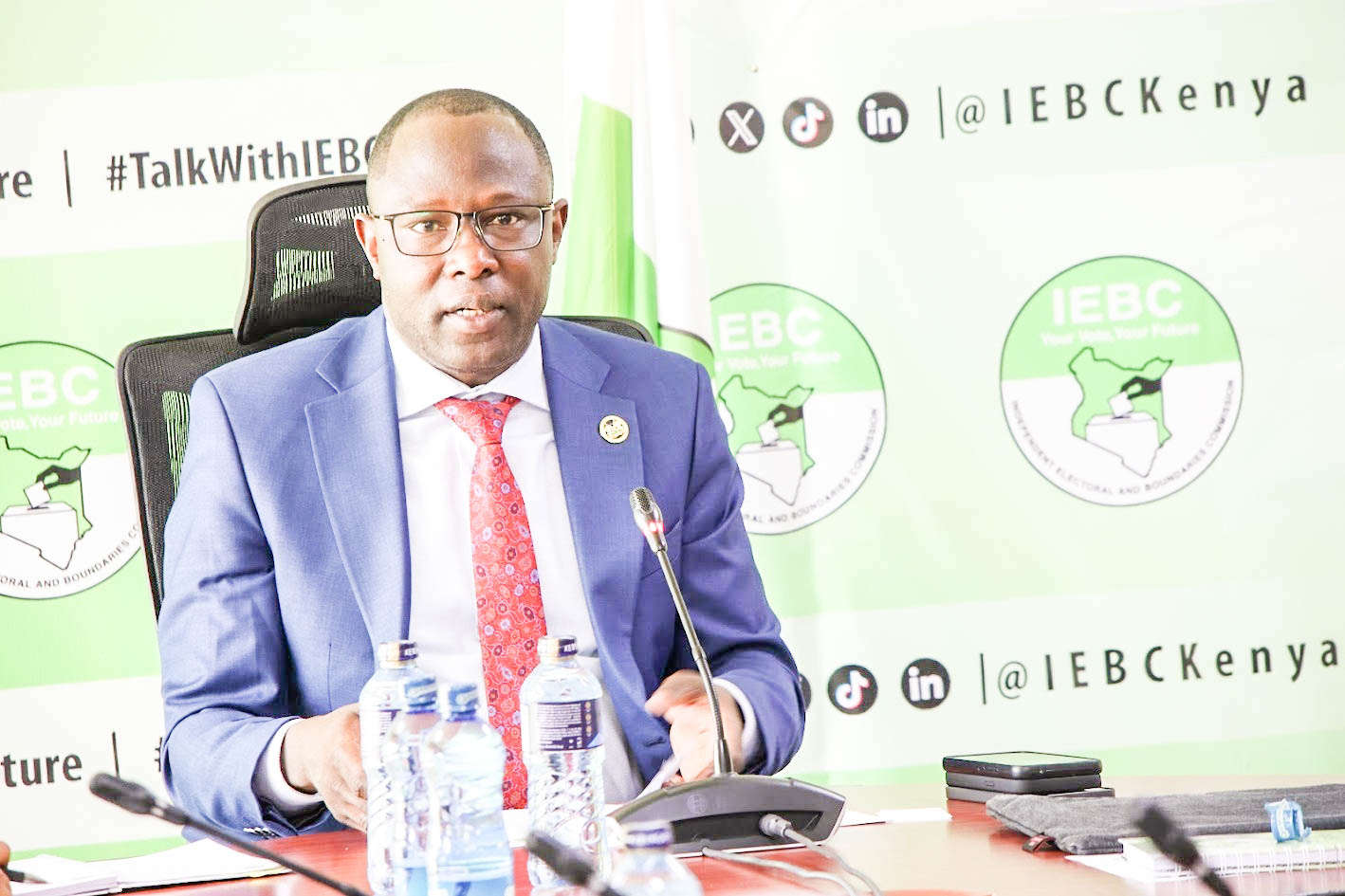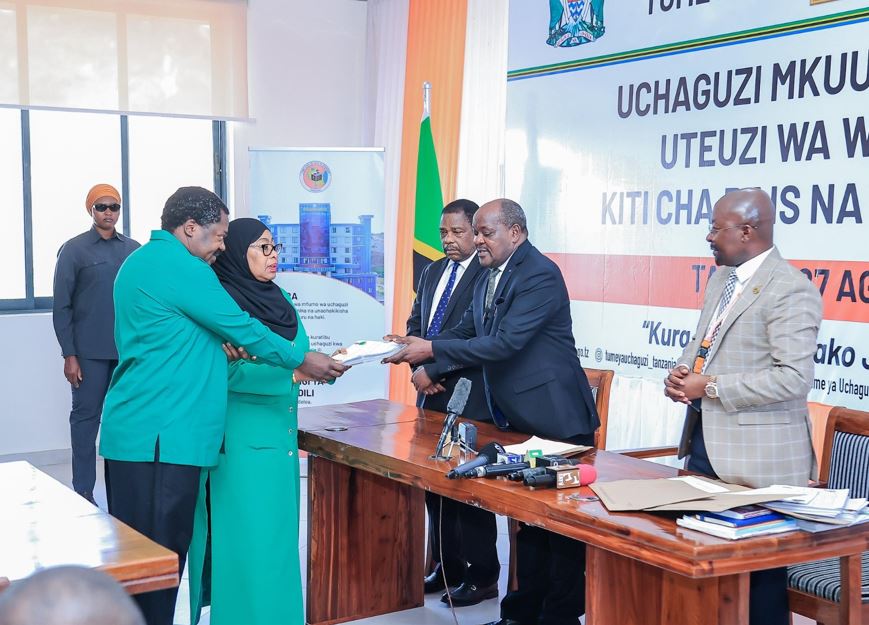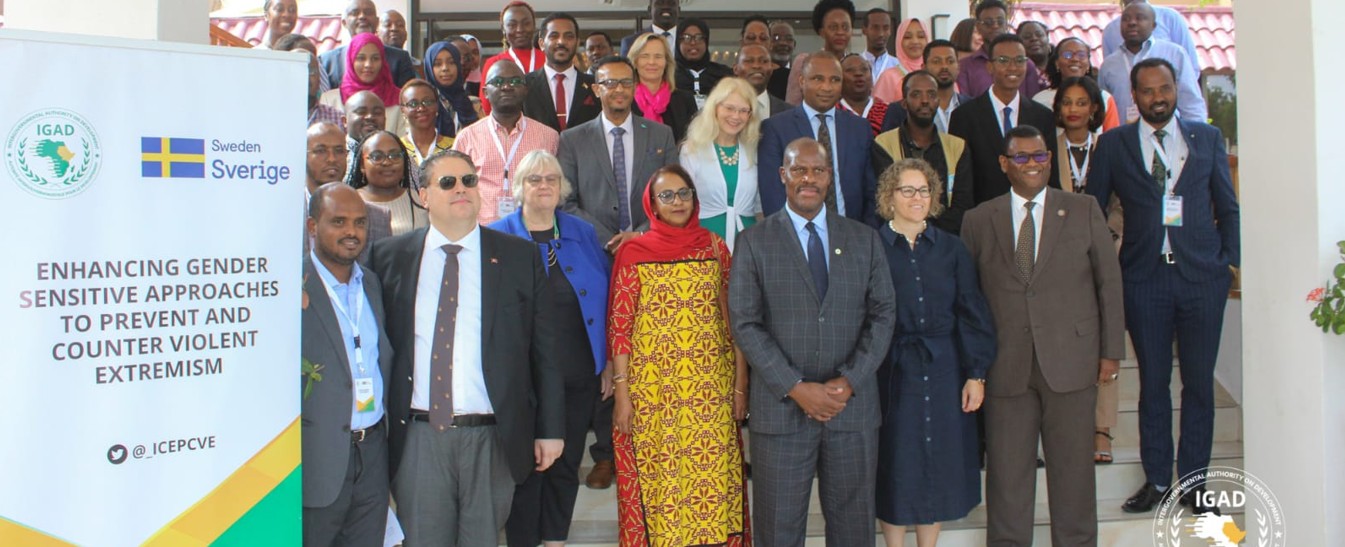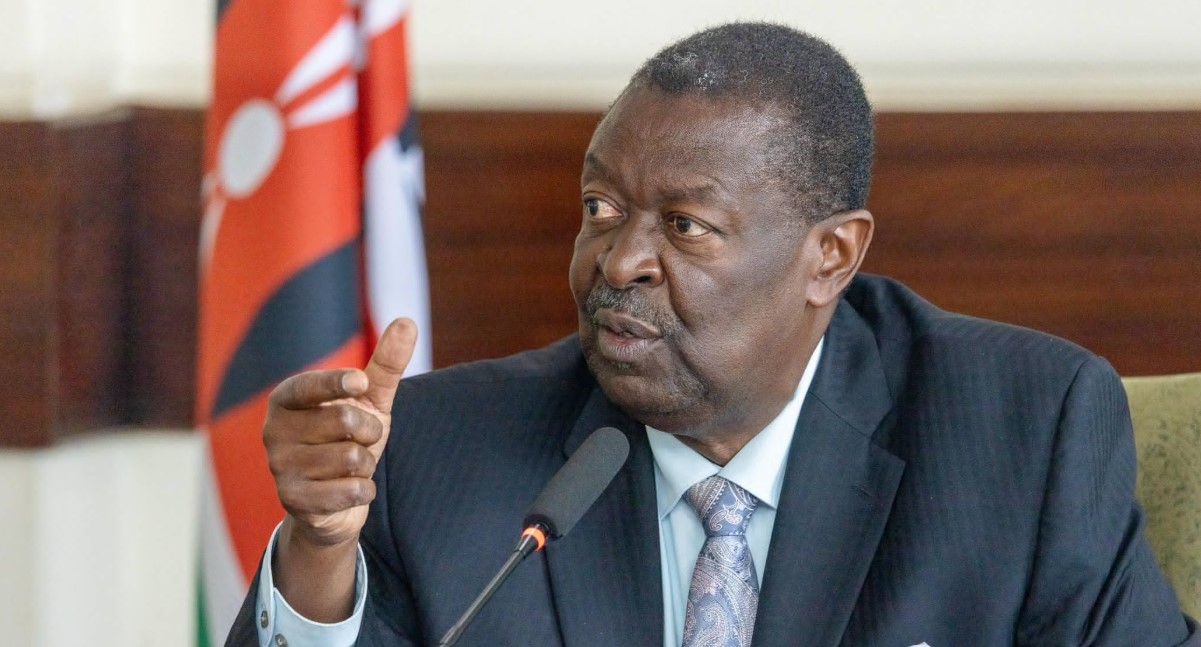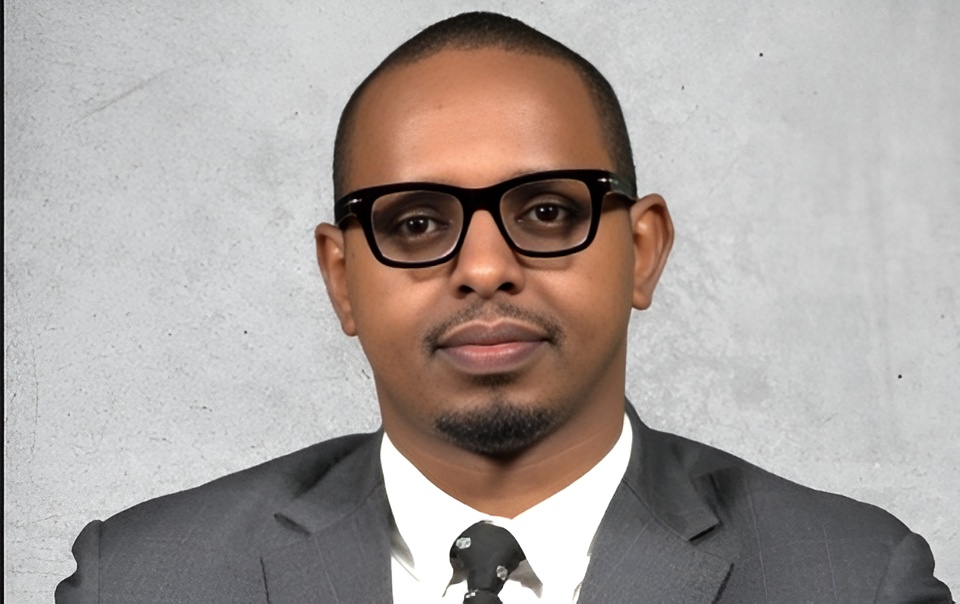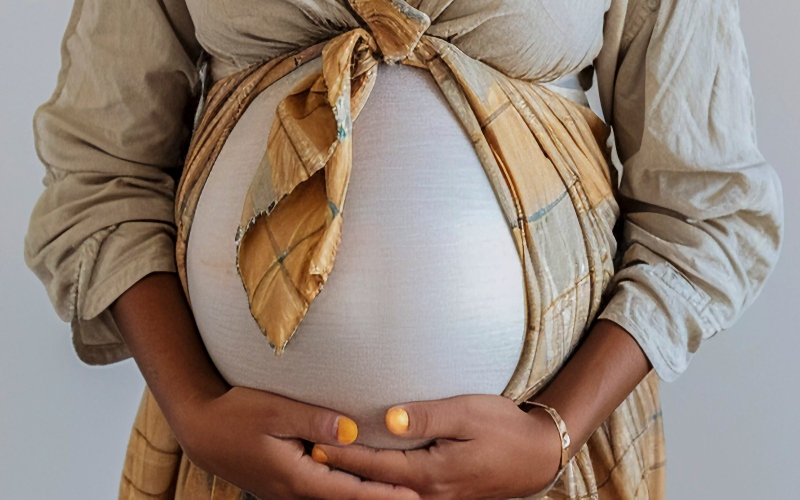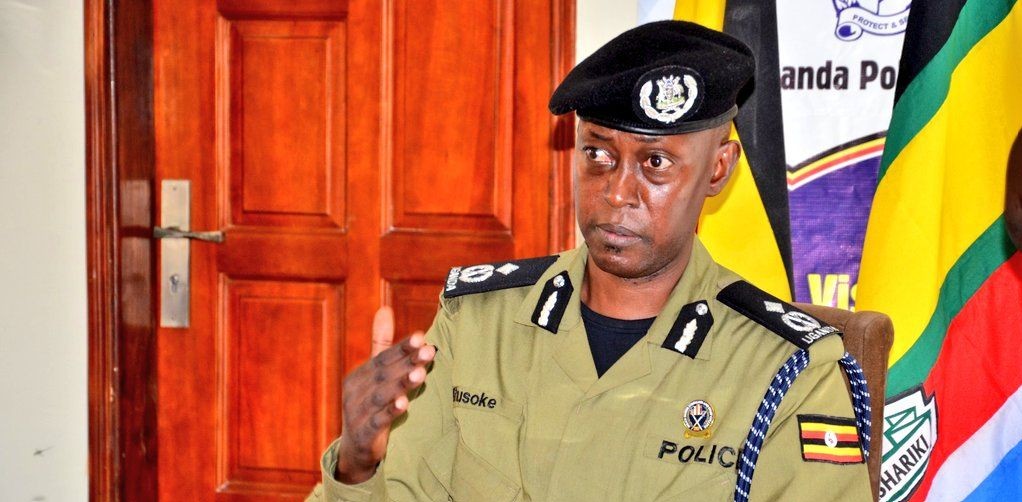Revisiting CHAN 2025 draw and Harambee Stars’ history with groups of death
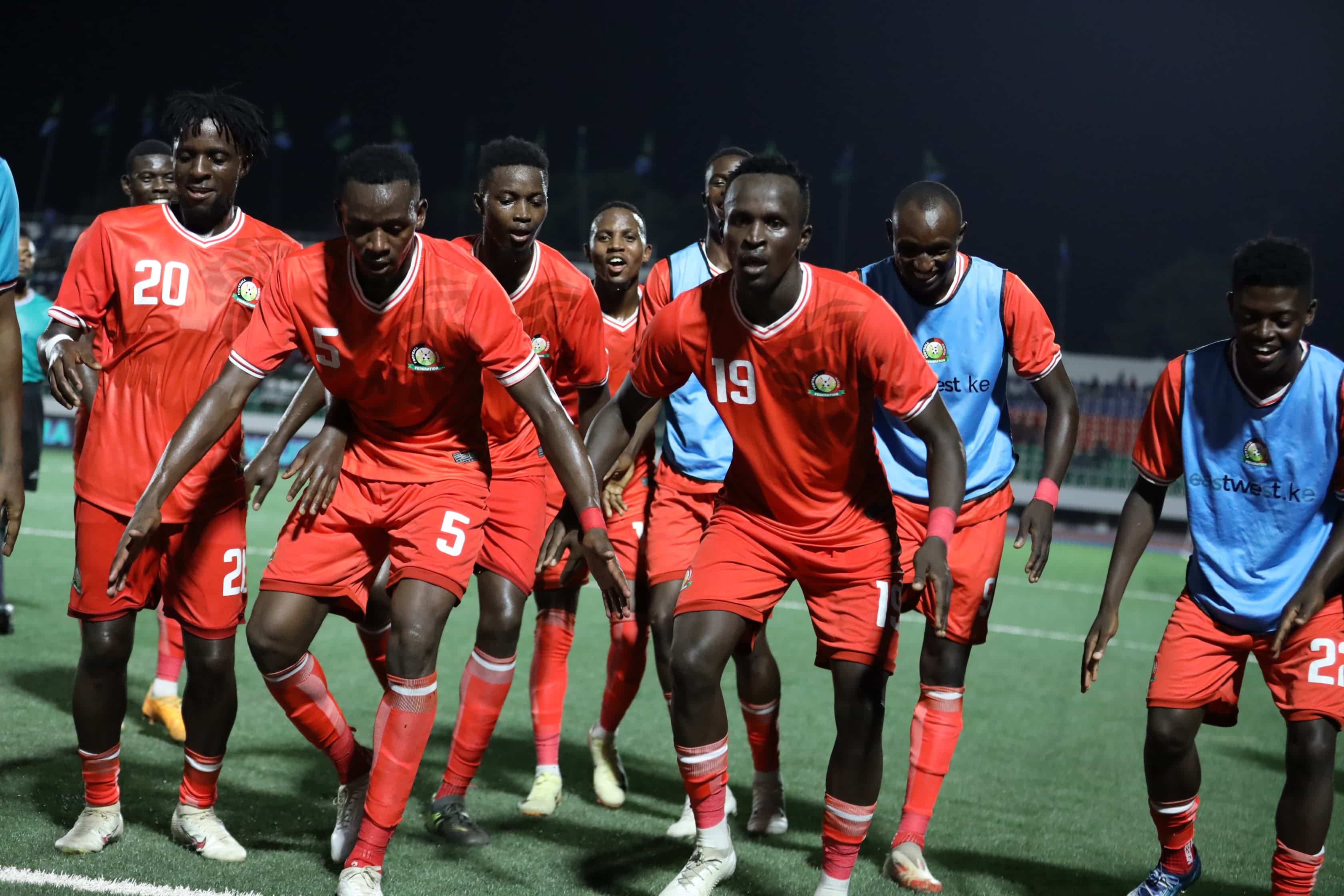
Harambee Stars will need to rise to the occasion after landing in the tournament’s most competitive group, as revealed during the official draw in Nairobi.
The CHAN 2025 Draw, conducted at the Kenyatta International Convention Centre on Wednesday, January 15, 2025, dealt Harambee Stars a tough hand. Despite the process being a random selection of coloured balls from a clear glass bowl, the outcome placed CHAN 2025 co-hosts and competition debutants Kenya in the feared “Group of Death,” raising eyebrows with its unforgiving outcome.
At a packed Tsavo Ballroom on that night, the audience comprising Sports CS Salim Mvurya, his Tanzania and Uganda counterparts, Peter Ogwang and Professor Palamagamba John Aidan Mwaluko Kabudi, and the presidents of Kenya, Tanzania, and Uganda football federations, – Hussein Mohammed, Wallace Karia, and Moses Magogo – marvelled at the draw’s cruel precision to pair the seeded Harambee Stars in Group A of the 19-team tournament with two-time CHAN winners Morocco and DR Congo, 2011 finalists Angola, and Zambia, who finished third in the inaugural edition of CHAN held in 2009.
More To Read
- Starlets one game away from historic WAFCON return after nine-year absence
- Harambee Starlets set to face Gambia in final WAFCON qualifier
- Bandari's Farouk Shikalo seals move to Ethiopian giants Saint George
- Harambee Stars up two places in latest FIFA rankings
- McCarthy lauds Ivory Coast as Harambee Stars end World Cup quest with defeat
- Harambee Stars edge 10-man Burundi 1–0 in World Cup qualifier as Ogam’s strike secures vital win
In Group B, tournament co-hosts Tanzania, who were also seeded, also found themselves in a formidable group comprising: the upcoming Madagascar who finished third at the last CHAN; Mauritania, an emerging force in African football who reached the last eight at CHAN 2022; Burkina Faso, who return determined to progress to the knockout stages for the first time after group stage exit in their last three appearances; and, debutants Central African Republic.
Uganda, the tournament’s other co-host, was the seeded team in Group C. Uganda holds the record of the most CHAN appearances, six, without ever progressing beyond the group stages.
Their group also contains no pushovers as they will come up against: Niger, who finished fourth at the last CHAN; Guinea, who finished 4th in 2016 and 3rd in 2020; and, two teams which were labelled Q1 and Q2 in the draw as they will be determined after seven teams – Algeria, Comoros, Egypt, Gabon, The Gambia, Malawi, and South Africa – contest a repechage tournament.
The likelihood that Algeria, runners-up on home soil at CHAN 2022 and Egypt, who will be making their debut if they qualify, may join Group C will throw a spanner in the works for the Uganda Cranes in their bid to qualify for the knockout stages at CHAN for the first time in their history.
Defending champions Senegal was the fourth seeded team and they were put in a relatively strong Group D which contains Congo (two-time quarterfinalists), Sudan (finished 3rd in 2011 and 2018), and Nigeria (finished 3rd in 2014 and 2nd in 2018).
CHAN 2025 will have competitive groups but Kenya’s pool stands out
While action in Groups B, C, and D, also promise fireworks, when previous tournament experience is factored in, it is easy to see why Group A is deemed to be the most competitive and a bad hand for Kenya.
On average, even with Kenya ranking as a debutant, Group A teams boast more tournament experience and accolades than teams in the other three groups, as shown in figures Figure 1 and Figure 2.
DR Congo, 26 matches, and Morocco, 19 matches, in particular have played more CHAN matches than any other nation in the history of the competition. With 12 wins each, they also hold the record of most matches won in CHAN, a statistic that they back with being the competition’s most successful team with two titles each. Morocco, who did not compete at the last CHAN despite qualifying for the competition owing to a diplomatic row with CHAN 2022 hosts Algeria, are also on a 13-match unbeaten run, the longest in the history of CHAN.
Zambia, on the other hand, holds the CHAN record of most appearances without ever being eliminated at the group stages. CHAN 2025 will be the Chipolopolo’s fifth appearance with their previous four seeing them finish 3rd in 2009 and suffer quarterfinal exits in 2016, 2018, and 2020. Along with Algeria (six matches), Tunisia (six matches), and Madagascar (two matches), Zambia (12 matches) is one four teams that has never lost a group stage match at CHAN. Ironically, despite their mastery of the CHAN group stages, Zambia has never won a knockout match at CHAN.
On their part, Angola has drawn the most CHAN matches, eight, among the 17 teams that have already qualified for CHAN 2025. Half of those draws came when they finished second in 2011, a testament to their resoluteness and potential to ride on luck on their way to achieving glory.
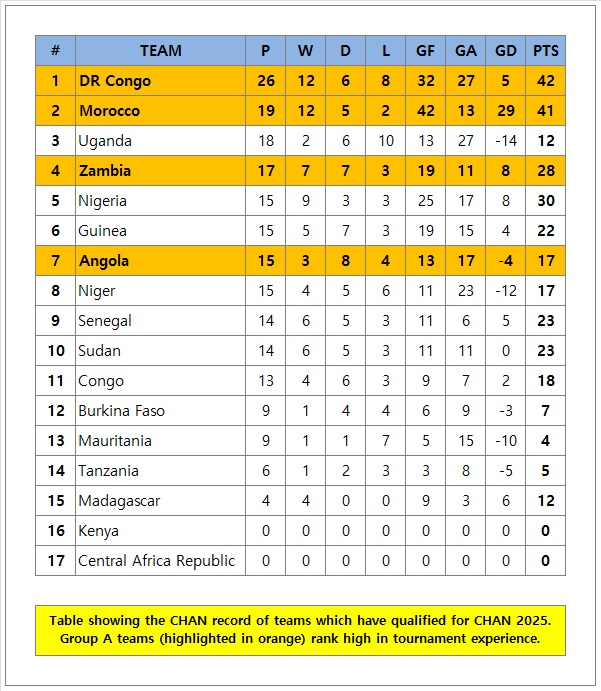 Table showing the CHAN record of teams which have qualified for CHAN 2025. Kenya's opponents in Group A (highlighted in orange) rank high in tournament experience.
Table showing the CHAN record of teams which have qualified for CHAN 2025. Kenya's opponents in Group A (highlighted in orange) rank high in tournament experience.
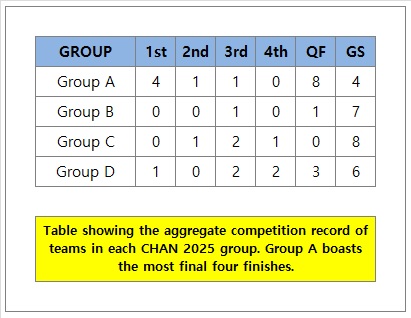 Kenya's opponents in Group A of CHAN 2025 boast six semifinal appearances. Teams in the other groups combine for seven last four appearances.
Kenya's opponents in Group A of CHAN 2025 boast six semifinal appearances. Teams in the other groups combine for seven last four appearances.
Another factor that casts the draw as a bad hand for Kenya is their record against the other four teams in Group A.
While Kenya’s head-to-head record with Angola is evenly-poised as shown in Figure 3, the same cannot be said of Harambee Stars encounters with DR Congo, Morocco, and Zambia. The latter three have dominated Kenya in the past with Morocco never losing a match against Harambee Stars.
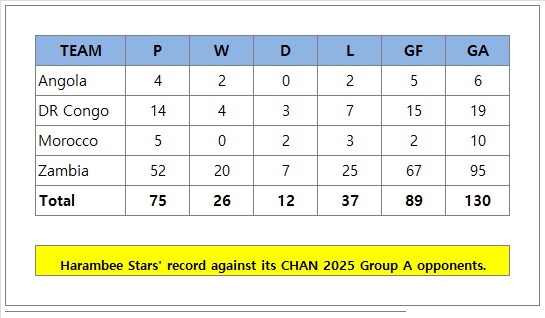 Kenya has never beaten Morocco and have also been dominated by DR Congo and Zambia in the past.
Kenya has never beaten Morocco and have also been dominated by DR Congo and Zambia in the past.
Mariga’s magical hands
That the tournament was postponed from February to August, a month Kenyans associate with ill luck, the morbid labelling of Kenya’s group means that as far as being unlucky goes, Harambee Stars have been paid in advance.
Before the draw, the chances of Kenya being pooled with those four teams stood at a measly 0.3%. However, sitting in the venue’s gallery which was reserved for the media, I witnessed the schadenfreude permeate the clairvoyance of Kenya’s suave and tech-savvy cohort of millennial and Gen-Z sports journalists and content creators as their draw predictions inflated that remote chance to 100%.
At each turn, before the draw conductor directed his assistants to pick the team joining Kenya’s group, this coterie of Kenyan football connoisseurs demonstrated a flawless exhibition of their time-travelling abilities.
Morocco! Angola! DR Congo! Zambia! Their audible murmurs correctly predicted the teams that joined Kenya’s group, making the draw assistants’ uttering and revelation of the four teams’ names to the audience a formality they greeted with jolting excitement at their prophesying talent.
Their power of manifestation had turned what had at first seemed as a remote possibility to a tantalising buffet of David vs Goliath contests that Kenyans can look forward to in August. “We will watch some great matches,” they said animatedly.
After the draw, Samson Adamu, CAF’s Director of Competitions who served as the draw’s conductor, cheekily praised FKF Vice President McDonald Mariga, who was one of the three draw assistants, for having magical hands in reference to the former Harambee Stars picking Morocco as the first team to join Kenya in Group A.
The other two draw assistants were Mrisho Ngassa, the first Tanzanian footballer to make 100 appearances for the Taifa Stars, and Hassan Wasswa, a midfield dynamo who starred for the Uganda Cranes and a plethora of clubs in Africa and Europe.
While Adamu had no cheeky remark on Ngassa’s and Wasswa’s performance in the exercise, extrapolating the comment he made about Mariga sparking the excited gasps that put emotional and physical sensations to Kenya’s draw picks, one can conclude that Ngassa, who drew Angola to join Kenya and Morocco in Group A, and Wasswa, who added DR Congo and Zambia to Group A to complete that blockbuster pool, had the hands of sorcerers.
Angola, set to appear at CHAN for the fifth time, had never been pooled in Group A before. As had DR Congo, whose previous six appearances at CHAN saw them pooled in Group B (four times), C (once), and D (once). Zambia, on the other hand, after playing out Groups B and D (twice) at their last three CHANs, will be returning to Group A for the first time since their debut at the first edition of CHAN in 2009.
While Morocco’s fifth appearance at CHAN will see them attempt to progress to the knockout stages from Group A for the third time, the rarity of Angola, DR Congo, and Zambia featuring in Group A compounds the peculiarity of the randomness that fashioned Group A of CHAN 2025.
What CAF did differently
Mariga, Ngassa, and Wasswa stood behind three red plinths with their contrasting physique and dress sense projecting to the audience and viewers their legend in East African football.
The three plinths, each propping a clear glass bowl with coloured balls in it, were decorated with the tournament’s logos and were labelled A, B, and C respectively to indicate which pot the three footballers will be drawing teams from. It was an arrangement that illustrated the draw’s procedure as Adamu, looking executive behind a broad red lectern bearing the CHAN 2025 emblem, directed the three former footballers at every turn to pick balls from the glass bowls before accompanying their picks with humour and a stat about a picked team.
Mariga, standing the closest to Adamu, drew teams from Pot A which contained Congo, Niger, Madagascar, and Morocco.
Ngassa was responsible for picking the teams from Pot B which contained Angola, Guinea, Mauritania, and Sudan.
Wasswa was the busiest of the trio as he was in charge of Pot C which contained Burkina Faso, debutants Central African Republic, DR Congo, Nigeria, Zambia, and the two teams labelled Q1 and Q2.
The tournament’s three co-hosts – Kenya, Tanzania, and Uganda – and defending champions Senegal were seeded and pre-placed in Groups A, B, C, and D respectively.
Adamu stated that the 13 remaining teams in Wednesday’s draw were classified into those three pots based on their performances in the last three CHAN tournaments. However, neither he, nor CAF through its media channels, explained the formula used to rank those 13 teams.
That was unlike the draws for previous CHAN tournaments. For instance, at CHAN 2022, CAF used performances from the four previous tournaments (2020, 2018, 2016, and 2014) to rank teams for seeding and classification into pots.
In the formula used then, CAF attached more weight to the most recent performance and that saw teams having their results from the 2014, 2016, 2018, and 2020 CHAN tournaments multiplied by 1, 2, 3, and 4 points respectively.
Also, teams received 7 points for winning the tournament, 5 points for finishing second, 3 points for reaching the semi-finals, 2 points for elimination at the quarterfinals, and 1 point for failing to progress beyond the group stages.
For example, for CHAN 2022, Morocco was the top-ranked team with 53 points, a tally accumulated from winning CHAN 2020 (28 points), winning CHAN 2018 (21 points), exiting CHAN 2016 at the group stages (one point), and reaching the last eight at CHAN 2014 (three points).
Had that formula been used ahead of last Wednesday’s draw, it would have resulted in a minor change in Pot A and almost complete overhauls of Pot B and Pot C.
Mariga’s magical hands
That the tournament was postponed from February to August, a month Kenyans associate with ill luck, the morbid labelling of Kenya’s group means that as far as being unlucky goes, Harambee Stars have been paid in advance.
Before the draw, the chances of Kenya being pooled with those four teams stood at a measly 0.3%. However, sitting in the venue’s gallery which was reserved for the media, I witnessed the schadenfreude permeate the clairvoyance of Kenya’s suave and tech-savvy cohort of millennial and Gen-Z sports journalists and content creators as their draw predictions inflated that remote chance to 100%.
At each turn, before the draw conductor directed his assistants to pick the team joining Kenya’s group, this coterie of Kenyan football connoisseurs demonstrated a flawless exhibition of their time-travelling abilities.
Morocco! Angola! DR Congo! Zambia! Their audible murmurs correctly predicted the teams that joined Kenya’s group, making the draw assistants’ uttering and revelation of the four teams’ names to the audience a formality they greeted with jolting excitement at their prophesying talent.
Their power of manifestation had turned what had at first seemed as a remote possibility to a tantalising buffet of David vs Goliath contests that Kenyans can look forward to in August. “We will watch some great matches,” they said animatedly.
After the draw, Samson Adamu, CAF’s Director of Competitions who served as the draw’s conductor, cheekily praised FKF Vice President McDonald Mariga, who was one of the three draw assistants, for having magical hands in reference to the former Harambee Stars picking Morocco as the first team to join Kenya in Group A.
The other two draw assistants were Mrisho Ngassa, the first Tanzanian footballer to make 100 appearances for the Taifa Stars, and Hassan Wasswa, a midfield dynamo who starred for the Uganda Cranes and a plethora of clubs in Africa and Europe.
While Adamu had no cheeky remark on Ngassa’s and Wasswa’s performance in the exercise, extrapolating the comment he made about Mariga sparking the excited gasps that put emotional and physical sensations to Kenya’s draw picks, one can conclude that Ngassa, who drew Angola to join Kenya and Morocco in Group A, and Wasswa, who added DR Congo and Zambia to Group A to complete that blockbuster pool, had the hands of sorcerers.
Angola, set to appear at CHAN for the fifth time, had never been pooled in Group A before. As had DR Congo, whose previous six appearances at CHAN saw them pooled in Group B (four times), C (once), and D (once). Zambia, on the other hand, after playing out Groups B and D (twice) at their last three CHANs, will be returning to Group A for the first time since their debut at the first edition of CHAN in 2009.
While Morocco’s fifth appearance at CHAN will see them attempt to progress to the knockout stages from Group A for the third time, the rarity of Angola, DR Congo, and Zambia featuring in Group A compounds the peculiarity of the randomness that fashioned Group A of CHAN 2025.
What CAF did differently
Mariga, Ngassa, and Wasswa stood behind three red plinths with their contrasting physique and dress sense projecting to the audience and viewers their legend in East African football.
The three plinths, each propping a clear glass bowl with coloured balls in it, were decorated with the tournament’s logos and were labelled A, B, and C respectively to indicate which pot the three footballers will be drawing teams from. It was an arrangement that illustrated the draw’s procedure as Adamu, looking executive behind a broad red lectern bearing the CHAN 2025 emblem, directed the three former footballers at every turn to pick balls from the glass bowls before accompanying their picks with humour and a stat about a picked team.
Mariga, standing the closest to Adamu, drew teams from Pot A which contained Congo, Niger, Madagascar, and Morocco.
Ngassa was responsible for picking the teams from Pot B which contained Angola, Guinea, Mauritania, and Sudan.
Wasswa was the busiest of the trio as he was in charge of Pot C which contained Burkina Faso, debutants Central African Republic, DR Congo, Nigeria, Zambia, and the two teams labelled Q1 and Q2.
The tournament’s three co-hosts – Kenya, Tanzania, and Uganda – and defending champions Senegal were seeded and pre-placed in Groups A, B, C, and D respectively.
Adamu stated that the 13 remaining teams in Wednesday’s draw were classified into those three pots based on their performances in the last three CHAN tournaments. However, neither he, nor CAF through its media channels, explained the formula used to rank those 13 teams.
That was unlike the draws for previous CHAN tournaments. For instance, at CHAN 2022, CAF used performances from the four previous tournaments (2020, 2018, 2016, and 2014) to rank teams for seeding and classification into pots.
In the formula used then, CAF attached more weight to the most recent performance and that saw teams having their results from the 2014, 2016, 2018, and 2020 CHAN tournaments multiplied by 1, 2, 3, and 4 points respectively.
Also, teams received 7 points for winning the tournament, 5 points for finishing second, 3 points for reaching the semi-finals, 2 points for elimination at the quarterfinals, and 1 point for failing to progress beyond the group stages.
For example, for CHAN 2022, Morocco was the top-ranked team with 53 points, a tally accumulated from winning CHAN 2020 (28 points), winning CHAN 2018 (21 points), exiting CHAN 2016 at the group stages (one point), and reaching the last eight at CHAN 2014 (three points).
Had that formula been used ahead of last Wednesday’s draw, it would have resulted in a minor change in Pot A and almost complete overhauls of Pot B and Pot C.
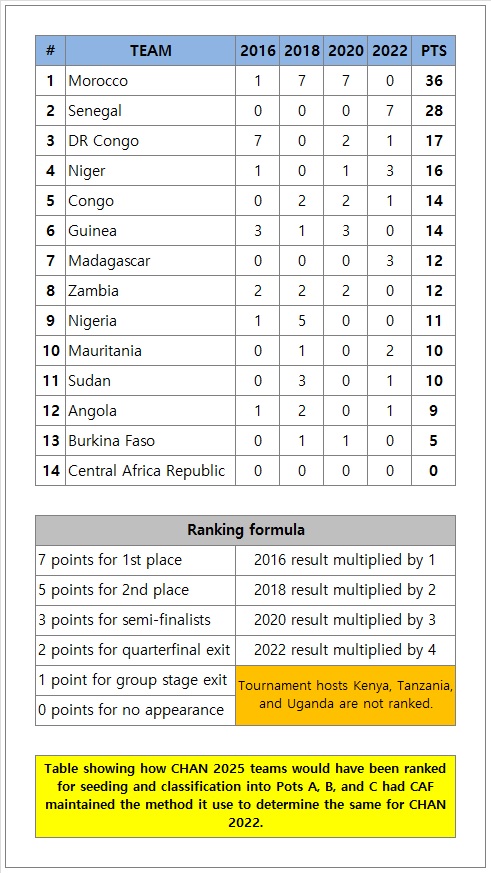 How CHAN 2025 would have been ranked for seeding and classification into Pot A, B, and C had CAF maintained the formula it used to determine the same at CHAN 2022.
How CHAN 2025 would have been ranked for seeding and classification into Pot A, B, and C had CAF maintained the formula it used to determine the same at CHAN 2022.
Morocco (36 points), Niger (16 points), and Congo (14 points) would have retained their spot in Pot A while Madagascar (12 points) would have slipped to Pot B and have their place taken by DR Congo (17 points).
In Pot B, only Guinea (14 points) would have survived while being joined by Madagascar, Nigeria (12 points), and Zambia (11 points), as Angola (9 points), Mauritania (10 points), and Sudan (10 points) lose their draw prestige to settle in Pot C with Burkina Faso (five points) debutants Central African Republic (zero points).
It is left to speculation as to why CAF decided not to reveal the formula used to rank the teams and why they decided to shrink the period of assessment from the last four CHAN tournaments to just the previous three competitions.
Further, if the seeding and ranking method from the last CHAN was used, it is possible that CAF would have seen its tradition of seeding the defending champion tested as Senegal, with 28 points, would have ranked lower than Morocco, 36 points. Knowing the intrigues in African football, it is likely that Morocco would have agitated to be seeded at the expense of Senegal.
Kenya is no stranger to “Groups of Death”
However, even if CAF would have opted to seed Morocco instead of Senegal for the CHAN 2025 Draw and applied the same model it used to seed and rank teams before the draw for CHAN 2022, as it can be deduced from above, there would still have been a chance that Kenya would have found itself in the so-called “Group of Death”.
If anything, Kenya co-hosting the tournament with Tanzania and Uganda, may have worked against Harambee Stars securing a favourable draw. With the tournament designed to have four groups, seeding the three co-hosts left strong teams like Morocco unseeded. Had Kenyan been the only host, it is definite that Morocco and one of the trio of Congo, Niger, and Madagascar.
Asked for his views on the exercise by the Draw’s host Lavin Asego, Mariga wrote the following day’s headlines when he described Kenya’s pool as the “Group of Death” before adding that Harambee Stars will be well-prepared to give their best in a competitive group.
Interviews given by Harambee Stars assistant coach John Kamau and midfielder Kenneth Muguna further emphasised Mariga’s opinion, that a tough group will need Kenya to be at their very best.
Even with the surprise of last Wednesday’s draw, looking back to Harambee Stars previous appearances at AFCON, the only other major international football competition Harambee Stars has competed in, one can argue that being in the tournament’s Group of Death is familiar territory for Harambee Stars.
Unfortunately, contrary to what Mariga, Kamau, and Muguna expect of Harambee Stars in August, Kenya majorly struggled to compete against the continent’s best when it appeared at AFCON in 1972, 1988, 1990, 1992, 2004, and 2019.
Such is the need for Harambee Stars to step up at international football competitions as, currently, they hold the AFCON record for most competition appearances without ever progressing beyond the group stages.
At AFCON 1972, they lost to tournament hosts Cameroon and collected draws against Mali and Togo.
In 1988, they collected only one point after losing to Egypt and Nigeria and drawing with Cameroon.
At the next AFCON in 1990, Harambee Stars drew with Senegal but lost against Cameroon and Zambia.
In 1992, the expansion of AFCON to 12 teams saw Kenya pooled with hosts Senegal and Nigeria. They lost both matches but Mickey Weche’s goal in the 2-1 loss to Nigeria ended a 20-year goal drought at AFCON.
Harambee Stars did not appear at AFCON again until 2004 and when they showed up in Tunisia, Mali and Senegal, with their contingent of European-born footballers who took advantage of a new FIFA rule that allowed footballers to switch allegiance to the African countries, welcomed Kenya back to the African football showpiece with 3-1 and 3-0 defeats respectively. However, there was a silver lining to Kenya’s campaign in Tunisia as a 3-0 victory over Burkina Faso saw Harambee Stars win for the first ever at AFCON.
The win against the Burkinabes was followed by a 15-year absence from AFCON which ended in 2019 when Kenya, yet again, found themselves in the same group with Senegal. The inclusion of Algeria in that group promised another tough outing for Kenya but the addition of Tanzania provided a tantalising East African Derby to look forward to. Kenya defeated Tanzania 3-2 but losses against Algeria (2-0) and Senegal (3-0) saw them return home early.
The draw’s rehearsal
Before the CHAN 2025 Draw on Wednesday last week, CAF held two rehearsal sessions, one on Tuesday evening and another on Wednesday morning. Perhaps, those rehearsals informed the inside jokes between the draw’s conductor Adamu and his three draw assistants – Mariga, Ngassa, and Wasswa.
For Mariga to have “magical hands” as Adamu quipped, it renders that statement to the speculation that Mariga’s picking Morocco to join Kenya in Group A during the main event was an action perfected during the rehearsals.
In a way, CHAN 2025 seems like déjà vu for Harambee Stars in the difficulty they will encounter to establish their supremacy in African football but with the tournament seven months away, Kenya have enough time to train to deliver magical moments in August.
Top Stories Today
